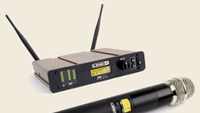Line 6 shows XD-series digital wireless at Summer NAMM

Digital modeling technology specialist Line 6 showed its new XD-series line of digital wireless microphone systems at last week’s NAMM Show in Nashville, TN, with product line manager Don Boomer providing an exclusive demo and interview on the show floor. Two versions of the system are offered, differing in receiver technology, range and maximum number of simultaneous systems. Both are available with either bodypack or handheld transmitters. The XD-V70 systems offer 12 simultaneous channels in a half-rack design with remotable antennas and professional 300ft range, while the 1/3-rack XD-V30 models provide 100ft range and six simultaneous systems. The XD-V70 handheld system also offers a range of capsule options.
All XD-series wireless systems feature full-range frequency response (10Hz to 20kHz) with 118dB dynamic range. Line 6 technologies including new DCL (Digital Channel Lock) and PDP (Proprietary Data Placement) provide encoded digital transmissions, govern against AF interference and audio artifacts, and ensure reliable operation in hostile RF environments. The system uses 24-bit, CD-quality A/D conversion, and the digital transmission scheme assures zero audio degradation with less than 4ms latency
“The XD-series systems feature our fourth-generation digital wireless technology when other companies are on their first,” said Don Boomer of Line 6. “The result is unmatched wireless performance, simplicity and sound quality worldwide — license free.”
The handheld models also include Line 6 modeling technology, with the sonic signatures of several popular vocal mics available via onboard DSP. “We have models based on Shure SM58, Beta 58, Sennheiser 835, Audix OM5, Audio-Technica 4100 and the ElectroVoice 767. So a customer can just push a button and select any of those that they want,” Boomer said. “You get basically the same output you would with the hardwired microphone version. So if you hot-swap from an SM58 mic into the back of my receiver, you don’t have to change anything at your board.” The pickup pattern is determined by the physical capsule on the transmitter. “That makes it possible to create things like a cardioid Beta 58,” he said. The bodypack systems are offered with a cardioid condenser lavalier microphone and use a standard TA4 connector to accommodate all standard pro lavaliers; the handheld offers the Line 6 DC7 as standard, and the transmitter is physically compatible with wireless capsules from Shure, Heil, Audix (with adapter) and EV.
The XD-series wireless operates in the license-free 2.4GHz band. “The 2.4GHz band is crowded. What we have is a frequency-hopping, FSK-type system that’s designed to work under just those conditions,” Boomer said. “In the real world, there’s tons of interference all the time, unless you’re in a cave. Understanding that, we created a packet transmission and analysis system that can handle that; it’s what it’s designed to do. Basically, it can lose an awful lot of data packets without suffering any audio loss. And because we’re only receiving ones and zeroes, the receiver doesn’t actually have to work that hard. We think it’s rather brilliant.”
The receiver of the XD-V70 system features external antennas that can be remotely located and offers optional pro-style paddle antennas. Antenna distribution is built in, enabling all 12 available channels to run through a single antenna pair. The XD-V30 version uses permanently integrated internal antennas, and both provide analog mic-level audio output only. “The receivers are very simple in this system,” Boomer said. “Because we’re just sending ones and zeroes, there’s nothing to adjust — no pads, no gain, no squelch. The user literally just assigns a channel, and that’s it. Everything else is handled by the system.”
Boomer is very bullish on Line 6’s decision to embrace the 2.4GHz band. “Between TV band devices and the National Broadband Plan, competition for bandwidth is going to get even more intense, especially below 700MHz. There’s going to be very little space to operate in, so you’re going to have to operate very efficiently in that space,” he said. “Digital systems have inherent benefits in that regard. For instance, they just don’t ‘understand’ interference. Everything that is not a recognized one or zero is just thrown away, so stray RF hums and buzzes disappear. In addition, a good digital system doesn’t require a compander, which gives them superb transient response and huge dynamic range.”
All XD-series digital wireless systems are scheduled to ship in the second week of July.
Get the TV Tech Newsletter
The professional video industry's #1 source for news, trends and product and tech information. Sign up below.
